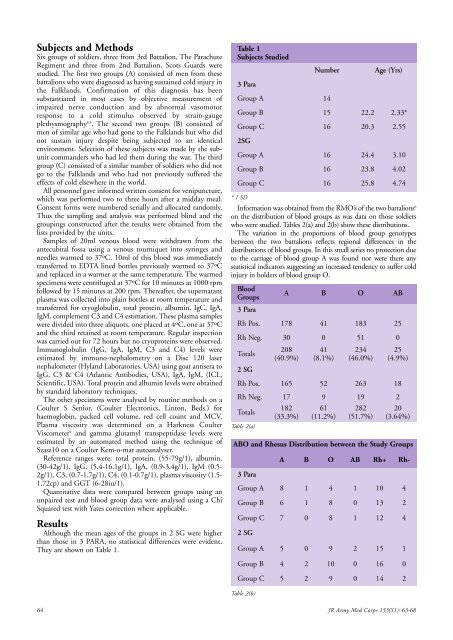Falklands war 25TH anniversarY - Boekje Pienter
Falklands war 25TH anniversarY - Boekje Pienter
Falklands war 25TH anniversarY - Boekje Pienter
You also want an ePaper? Increase the reach of your titles
YUMPU automatically turns print PDFs into web optimized ePapers that Google loves.
Subjects and Methods<br />
Six groups of soldiers, three from 3rd Battalion, The Parachute<br />
Regiment and three from 2nd Battalion, Scots Guards were<br />
studied. The first two groups (A) consisted of men from these<br />
battalions who were diagnosed as having sustained cold injury in<br />
the <strong>Falklands</strong>. Confirmation of this diagnosis has been<br />
substantiated in most cases by objective measurement of<br />
impaired nerve conduction and by abnormal vasomotor<br />
response to a cold stimulus observed by strain-gauge<br />
plethysmography 8,9 . The second two groups (B) consisted of<br />
men of similar age who had gone to the <strong>Falklands</strong> but who did<br />
not sustain injury despite being subjected to an identical<br />
environment. Selection of these subjects was made by the subunit<br />
commanders who had led them during the <strong>war</strong>. The third<br />
group (C) consisted of a similar number of soldiers who did not<br />
go to the <strong>Falklands</strong> and who had not previously suffered the<br />
effects of cold elsewhere in the world.<br />
All personnel gave informed written consent for venipuncture,<br />
which was performed two to three hours after a midday meal.<br />
Consent forms were numbered serially and allocated randomly.<br />
Thus the sampling and analysis was performed blind and the<br />
groupings constructed after the results were obtained from the<br />
lists provided by the units.<br />
Samples of 20ml venous blood were withdrawn from the<br />
antecubital fossa using a venous tourniquet into syringes and<br />
needles <strong>war</strong>med to 37ºC. 10ml of this blood was immediately<br />
transferred to EDTA lined bottles previously <strong>war</strong>med to 37ºC<br />
and replaced in a <strong>war</strong>mer at the same temperature. The <strong>war</strong>med<br />
specimens were centrifuged at 37ºC for 10 minutes at 1000 rpm<br />
followed by 15 minutes at 200 rpm. Thereafter, the supernatant<br />
plasma was collected into plain bottles at room temperature and<br />
transferred for cryoglobulin, total protein, albumin, IgC, IgA,<br />
IgM, complement C3 and C4 estimation. These plasma samples<br />
were divided into three aliquots, one placed at 4ºC, one at 37ºC<br />
and the third retained at room temperature. Regular inspection<br />
was carried out for 72 hours but no cryoproteins were observed.<br />
Immunoglobulin (IgG, IgA, IgM, C3 and C4) levels were<br />
estimated by immuno-nephalometry on a Disc 120 laser<br />
nephalometer (Hyland Laboratories, USA) using goat antisera to<br />
IgG, C3 & C4 (Atlantic Antibodies, USA), IgA, IgM, (ICL,<br />
Scientific, USA). Total protein and albumin levels were obtained<br />
by standard laboratory techniques.<br />
The other specimens were analysed by routine methods on a<br />
Coulter S Senior, (Coulter Electronics, Linton, Beds.) for<br />
haemoglobin, packed cell volume, red cell count and MCV.<br />
Plasma viscosity was determined on a Harkness Coulter<br />
Viscometer 9 and gamma glutamyl transpeptidase levels were<br />
estimated by an automated method using the technique of<br />
Szasz10 on a Coulter Kem-o-mat autoanalyser.<br />
Reference ranges were: total protein, (55-79g/1), albumin,<br />
(30-42g/1), IgG, (5.4-16.1g/1), IgA, (0.9-3.4g/1), IgM (0.5-<br />
2g/1), C3, (0.7-1.7g/1), C4, (0.1-0.7g/1), plasma viscosity (1.5-<br />
1.72cp) and GGT (6-28iu/1).<br />
Quantitative data were compared between groups using an<br />
unpaired test and blood group data were analysed using a Chi<br />
Squared test with Yates correction where applicable.<br />
Results<br />
Although the mean ages of the groups in 2 SG were higher<br />
than those in 3 PARA, no statistical differences were evident.<br />
They are shown on Table 1.<br />
Table 1<br />
Subjects Studied<br />
3 Para<br />
Number<br />
Group A 14<br />
Age (Yrs)<br />
Group B 15 22.2 2.33*<br />
Group C 16 20.3 2.55<br />
2SG<br />
Group A 16 24.4 3.10<br />
Group B 16 23.8 4.02<br />
Group C 16 25.8 4.74<br />
* 1 SD<br />
Information was obtained from the RMO’s of the two battalions 6<br />
on the distribution of blood groups as was data on those soldiers<br />
who were studied. Tables 2(a) and 2(b) show these distributions.<br />
The variation in the proportions of blood group genotypes<br />
between the two battalions reflects regional differences in the<br />
distributions of blood groups. In this small series no protection due<br />
to the carriage of blood group A was found nor were there any<br />
statistical indicators suggesting an increased tendency to suffer cold<br />
injury in holders of blood group O.<br />
Blood<br />
Groups<br />
3 Para<br />
A B O AB<br />
Rh Pos. 178 41 183 25<br />
Rh Neg. 30 0 51 0<br />
Totals<br />
2 SG<br />
208<br />
(40.9%)<br />
41<br />
(8.1%)<br />
234<br />
(46.0%)<br />
25<br />
(4.9%)<br />
Rh Pos. 165 52 263 18<br />
Rh Neg. 17 9 19 2<br />
Totals<br />
Table 2(a)<br />
3 Para<br />
182<br />
(33.3%)<br />
61<br />
(11.2%)<br />
282<br />
(51.7%)<br />
20<br />
(3.64%)<br />
ABO and Rhesus Distribution between the Study Groups<br />
A B O AB Rh+ Rh-<br />
Group A 8 1 4 1 10 4<br />
Group B 6 1 8 0 13 2<br />
Group C 7 0 8 1 12 4<br />
2 SG<br />
Group A 5 0 9 2 15 1<br />
Group B 4 2 10 0 16 0<br />
Group C 5 2 9 0 14 2<br />
Table 2(b)<br />
64 JR Army Med Corps 153(S1): 63-68

















